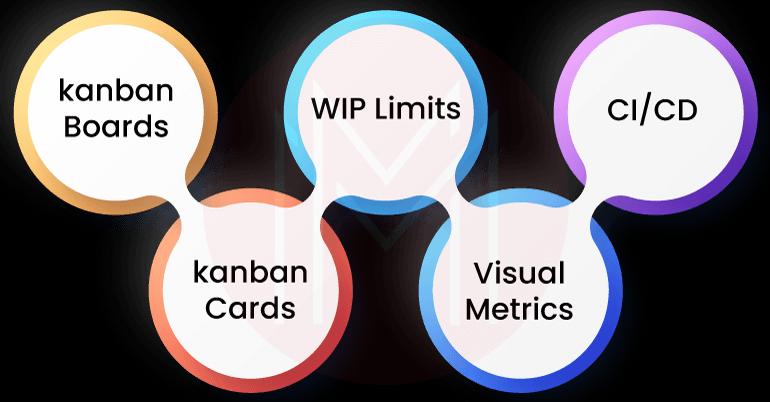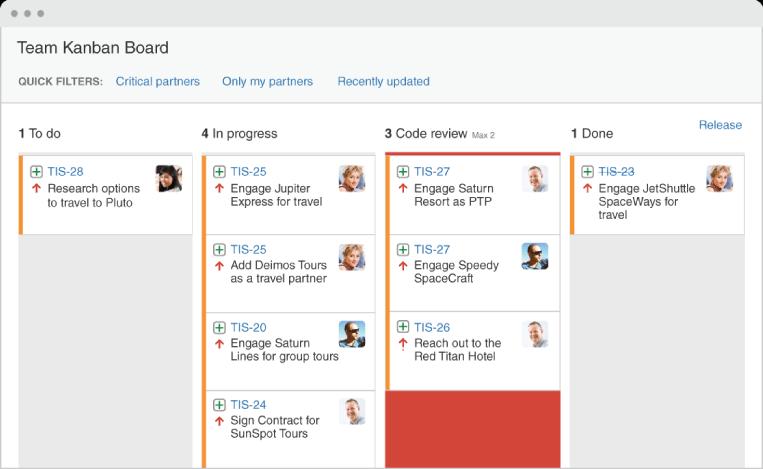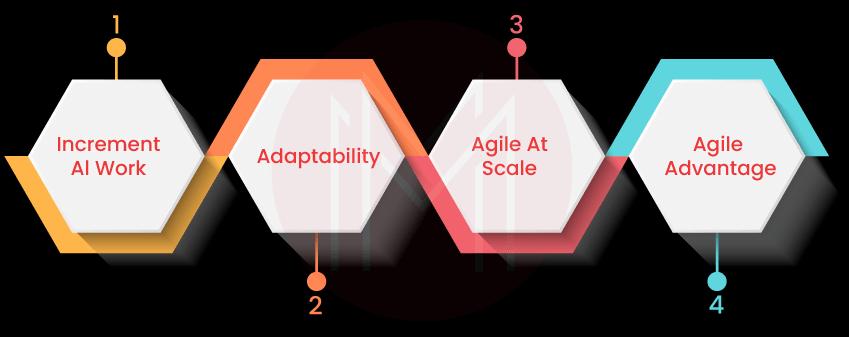Whether it is software development or any product development, changes in requirements or constructs are inevitable. The tools that use for the development should quickly adapt to the changes and ensure consistent delivery and quality. Simply put, they have to be agile in operations. This way, you might have heard about the terms Agile and Kanban widely across software development platforms.
Know that Agile is one of the popular methodologies that support rapid changes in the requirements while developing software. At the same time, Kanban is the framework that works based on Agile methodology. In a way, there are closely related with minor differences. This blog delves deep into Agile and Kanban and explores them in greater detail.
| Kanban vs Agile - Table of Contents |
What is Kanban?
Kanban is nothing but a popular Agile software development framework. It is one of the tools works based on the Agile methodology. Kanban uses Kanban boards that mainly focus on improving processes with the visual data displayed on the board. Any industry can embrace Kanban, but software development companies mostly use Kanban. This is because Kanban provides excellent features such as real-time communication, complete transparency, and much more. It’s no wonder workflows in the Kanban board can be managed by all the members of teams. As a result, it creates an overall responsibility for teams.
The great thing about Kanban is that it allows teams to focus on continuous delivery by adapting to the changes in the requirements. Especially, teams that are dealing with a lot of incoming requests can use Kanban confidently. No matter the size or priority of requests, Kanban ensures consistent work delivery based on the capacity of teams. As a whole, Kanban provides flexible planning and focus throughout the software development life cycle.
| If you want to enrich your career and become a professional in Agile, then visit Mindmajix - a global online training platform: "Agile Certification Training" This course will help you to achieve excellence in this domain. |
What are the Key Features of Kanban?
No wonder Kanban has many fantastic features for optimizing workflows and accelerating software development. Let’s take a look at them.

1. Kanban Boards: It is a tool to visualize and optimize workflows effectively. Every Kanban board has visual signals, delivery points, commitment points, columns, and WIP limits. A typical Kanban board will show a 3-step process: To-do, In-progress, and Done. However, you can add more steps based on requirements. With Kanban boards, you can identify dependencies between the software modules and solve them efficiently. Overall, you can get traceability, accessibility, and collaboration with the help of Kanban boards.

| Related Article: Jira Kanban Boards |
2. Kanban Cards: It is one of the essential components of Kanban boards. You can show every work item of a development process as a separate card on Kanban boards. With Kanban cards, you can view and track all the essential details of work items – at a glance. Not just that, everyone in the team can know about the work items, screenshots, responsible members, details of work items, time frame for completing the work items, and many more. These details will help you to reduce cycle times and complete workflows quickly.
3. WIP Limits: WIP is the short form of WorkInProgress. Know that every stage of a workflow will consist of many tasks. Kanban allows setting WIP limits for each stage based on teams’ capacity. As a result, you can avoid bottlenecks, reduce idleness, and increase the efficiency of workflows.
4. Visual Metrics: Kanban offers two types of reports: control charts and Cumulative Flow Diagrams (CFD). Here, Control charts provide visual data to identify the bottlenecks in workflows. Also, they show cycle times of issues as well as the average rolling time taken by teams. Here, cycle time is the total time taken to resolve an issue. Another metric, CFD, shows the number of issues that exist in each state of a workflow. In short, visual metrics allow teams to improve the efficiency of workflows by spotting issues at any stage.
5. CI/CD: Basically, Continuous Delivery is the process of deploying applications frequently, whereas Continuous Integration is nothing but the process of automatically building, testing, and deploying applications continuously. CI/CD pipeline helps deploy applications faster and, at the same time, ensures quality. And you can achieve Just-in-time and one-at-a-time delivery using the CI/CD pipeline.
What are the Advantages and Drawbacks of Kanban?
Are you still wondering how Kanban is continuing as an excellent agile framework? Let’s see the advantages of Kanban below.
- Kanban is an easy-to-use tool.
- Kanban boards can show all the current WIP items. So, you can track and control WIP limits closely and increase the efficiency of workflows.
- You can optimize Kanban cards effortlessly.
- You can prioritize work items in the backlog, allowing team members to choose the next work item based on priority.
- You can quickly identify causes for bottlenecks and take measures to resolve them. As a result, you can reduce cycle time.
- Kanban helps to avoid multitasking.
- It ensures transparency and collaboration among teams.
Drawbacks of Kanban:
No doubt Kanban has a few drawbacks as well. Let’s see the list as follows:
- Resizing Kanban cards is not an easy task
- Kanban boards don’t show all the needed details all the time. If you want to get more details, you need to open the projects separately.
- Outdated Kanban boards may cause issues, which will make the board overcomplicated.
- Predicting time frames for work items is not easy with Kanban boards.
What is Agile?
Agile is an iterative-based approach, which is usually leveraged for software development and project management. Also, it is a collaborative, self-organizing, cross-functional approach used to complete tasks for changing requirements. Agile overcomes the traditional Waterfall approach by providing a rapid and flexible response to changes. Essentially, Agile is a methodology that drives tools such as Kanban and Scrum. These tools work based on feedback and continuous improvements.
The critical thing about Agile is that it simplifies DevOps practices. As a result, developers and operations engineers can work together and enhance productivity with quality. Agile supports performing work in small increments. In other words, it divides the project into small pieces of work and then prioritizes it. Agile performs the continuous evaluation of plans, requirements, and results, which will help to adapt to changes rapidly. And it ensures open communication and collaboration among team members. By embracing Agile, teams can respond faster to changes, produce high-quality products, and achieve an excellent competitive advantage.
What are the Key features of Agile?
The agile methodology supports robust software development and adapting to changes quickly. Here are the reasons for the same.

1. Incremental Work: Essentially, Agile drives simultaneous and incremental works. Agile breaks the main project into smaller parts or workflows to achieve this. Know that workflow is a series of stages required to accomplish a task. Every Agile workflow consists of four stages: To Do, In-Progress, Code Review, and Done. They will be processed one by one incrementally.
2. Adaptability: With Agile methodology, you can adjust or customize workflows based on changes in the requirements or developing environment. That’s why Agile is best suitable for projects that demand frequent changes in requirements or constraints.
3. Agile at Scale: Agile allows scaling applications seamlessly. At the same time, it ensures the applications' practices, principles, and outcomes. This is because Agile principles need to be followed while scaling applications. The principles start from – defining roles to lean management. Agile undoubtedly increases transparency, encourages collaboration, and aligns works with speed while scaling.
4. Agile Advantage: Agile helps to model new behaviors in the software development process. In addition to developers, Agile supports architects, designers, product managers, and other people involved in projects. Because of this, Agile can be leveraged in every part of the business seamlessly. As a result, you can improve communication between all team members. Besides, agile allows automated testing and integration, integrate workflows, brings closeness between various tools, and so on.
| Related Article: Agile Metrics That Matter |
What are the Advantages and Drawbacks of Agile:
Are you still trying to figure out how Agile continues as one of the superior methodologies? No worries! Read the below to know more.
- Agile methodology allows customers to track their progress by involving them in the development lifecycle and allowing them to offer feedback. In return, you can get satisfied customers in the end.
- As Agile follows an iterative approach, you can improve the quality of products to the maximum level.
- Agile methodologies encourage adapting to changes quickly. It ensures consistent and flexible software development.
- Agile teams work in Sprints. It means you can evaluate progress in short periods, which helps estimate software delivery earlier and plan accordingly.
- It enhances communication among team members significantly
- On top of all, Agile ensures continuous improvement by encouraging collaboration and driving a cultural shift among team members in exchanging information.
Drawbacks of Agile:
Undeniably, there are a few drawbacks that exist for Agile too. Let’s read them below:
- Agile methodology is not suitable for long-term projects since the iterative method could mess up the long-term projects
- Documentation is not enough
- Agile demands excellent time-management skills for teams
- Short life cycles don’t allow to do complete design thinking
- Agile creates ‘scope creep’ issues
| Related Article: Agile Project Management |
What are the Main Differences between Kanban and Agile?
As mentioned earlier, Kanban is a tool that works based on Agile methodology. However, a few slight differences exist between the two. Let’s have a look at them below:
1. Approach: Agile is a methodology but not a tool, whereas Kanban is a tool that works based on Agile methodology. Kanban visualizes work items OR WIP through Kanban boards and Kanban cards. So, you can optimize work items or WIP and complete tasks quickly.
2. Structure of Workflows: As you know, Agile breaks the main project into smaller workflows, which will be easier to develop, test, and optimize. And it encourages a simultaneous and incremental workflow approach. Kanban follows a continuous workflow structure. The cards in the Kanban boards can be organized in such a way to show the flow of work items, which in turn helps to optimize them efficiently.
3. Roles: you don’t need to assign roles for managing Kanban boards. Instead, everyone in the team can manage boards. Simply put, Kanban encourages collective responsibility. On the other hand, other Agile methodologies like scrum use defined roles to manage tasks at various stages of the development lifecycle.
4. Metrics Used: Cycle time is one of the important metrics used in Kanban to track the progress of workflows. Control charts and CFD help to identify bottlenecks in workflows and improve throughput. Mainly, Kanban uses visual checks through Kanban boards, whereas other agile methodologies use tools like storyboards to track workflow progress.
5. Ease of use: Implementing the Kanban method is simple and doesn’t require any specific training. On the other hand, other Agile methodologies require training to handle the tools effectively.
6. Use cases: Kanban boards can be used for any project, whereas other Agile methodologies can be used based on the types of projects. Mainly, Kanban provides speedy delivery in shorter life cycles.
7. Ensuring Quality: Quality is ensured at every workflow stage while working with Kanban boards. Other Agile methodologies ensure quality only at the end of workflows.
| Related Article: Agile Certifications |
Conclusion:
At a glance, Agile is a methodology, and Kanban is one of the tools used to implement Agile methodology. Agile provides the ability to change workflows while developing software and allows you to develop high-quality software. Not just that, Agile empowers teams and encourages continuous improvement. On the other hand, Kanban provides visual aids to track the progress of workflows and optimize them based on changes – on the go. What’s more! All team members can manage Kanban boards. In return, it encourages collective responsibility
 On-Job Support Service
On-Job Support Service
Online Work Support for your on-job roles.

Our work-support plans provide precise options as per your project tasks. Whether you are a newbie or an experienced professional seeking assistance in completing project tasks, we are here with the following plans to meet your custom needs:
- Pay Per Hour
- Pay Per Week
- Monthly
| Name | Dates | |
|---|---|---|
| Agile Training | Dec 27 to Jan 11 | View Details |
| Agile Training | Dec 30 to Jan 14 | View Details |
| Agile Training | Jan 03 to Jan 18 | View Details |
| Agile Training | Jan 06 to Jan 21 | View Details |

Madhuri is a Senior Content Creator at MindMajix. She has written about a range of different topics on various technologies, which include, Splunk, Tensorflow, Selenium, and CEH. She spends most of her time researching on technology, and startups. Connect with her via LinkedIn and Twitter .














